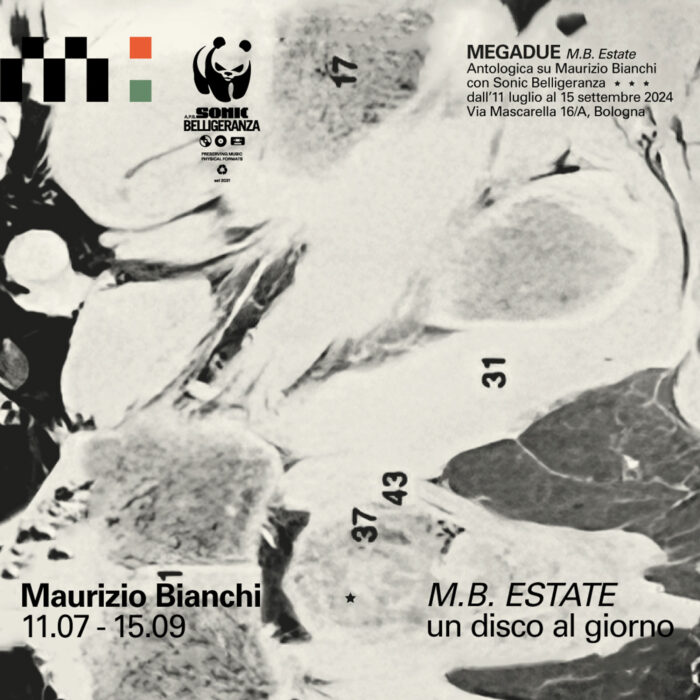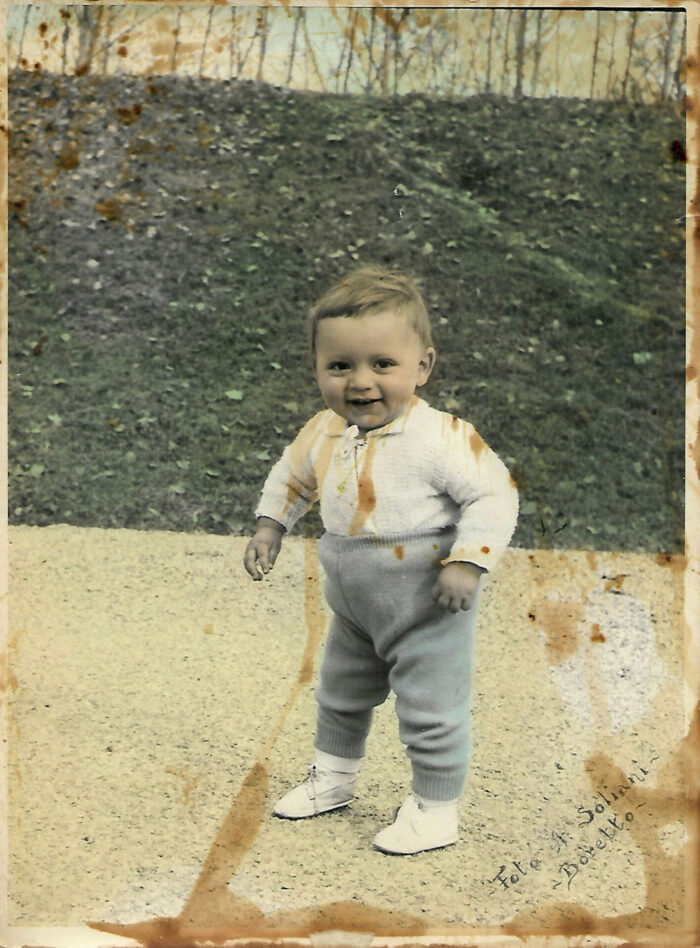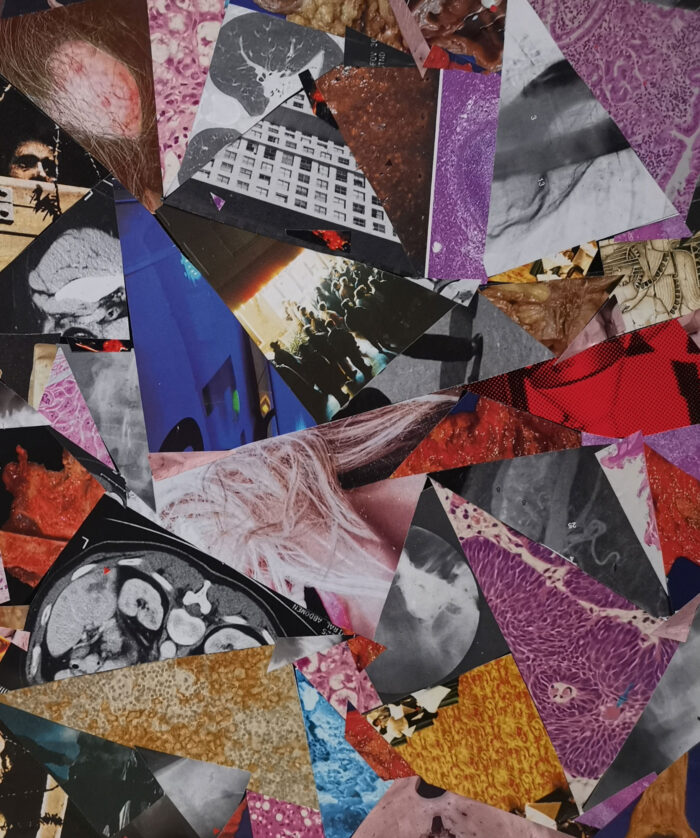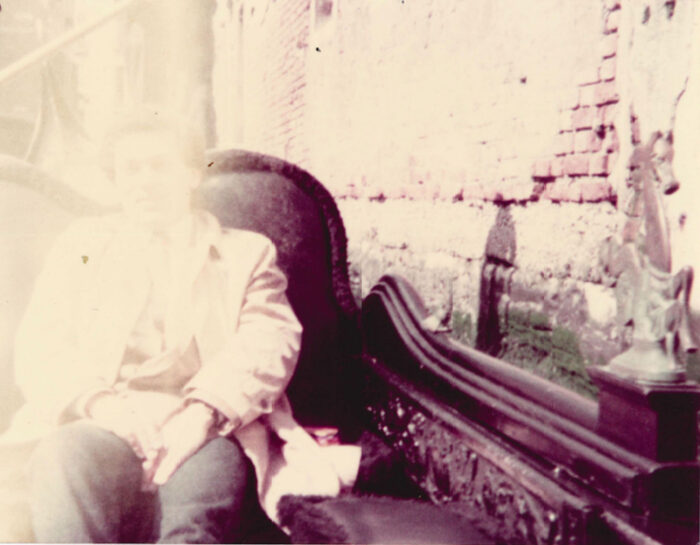The Elusive Dimension of Noise
On the work of Maurizio Bianchi
On Thursday, July 11 at 7 PM, Megadue and Sonic Belligeranza present M.B. Estate, an anthological sound exhibition dedicated to the industrial music pioneer Maurizio Bianchi (Pomponesco, 1955. Lives in Milan). The project will run until Sunday, September 15.
The eternal suffering of colors, the imminent and now inevitable collapse of an increasingly oppressive and contradictory contemporaneity, the desperate attempt to control the tyrannical hegemony of chaos: these could be words, more or less suitable, to describe some of the numerous soundscapes made by Maurizio Bianchi. As trivial or perhaps obvious as it may sound, the work of the composer originally from Pomponesco, but Milanese by adoption, seems to restore the dehumanizing process—still in the making—of collective and nihilistic alienation. Although some soothing moments and seemingly conciliatory or salvific passages occasionally surface among the obstinate, haunting, and muddy reverberations, the long tracks produced by Bianchi do not seem to leave any illusory hope for the listener. They lead the audience among the wispy and dissonant shadows that crowd a dead-end street, headed toward an unknown destination.

However, narrowing Bianchi’s immense oeuvre to repetitive descriptions with eerie and horrific overtones, as if his work constituted the alarming and extreme sonification of a now tangible dystopia or the distressing response to Brian Eno’s coeval ambient experiments, would risk being truly reductive. For more than 40 years, the musician’s discography has continued unabated, already crossing the absolutely unthinkable milestone of 300 releases a few years ago. From the first tapes released under the pseudonym Sacher-Pelz in 1979, following an amateurish attempt to start a punk band with other friends, to the Piano Decompositions of the early 2000s and the deconstruction of his own songs, Bianchi’s boundless catalog renders the complexity of a consistently heterogeneous production.
Concrete music, industrial, ambient, power electronics or drone? Bianchi’s pioneering work could be placed rightfully in a noisy time frame that embraces as much the experiments made by Luigi Russolo as it does the minimalism or the more recent harsh and noisecore exploits made by the Gerogerigegege. His production eschews any unambiguous classification. Loops and often arrhythmic patterns contribute to the visualization of a tortuous path of awareness, littered with self-destructive resignation and religious faith. If the duty of the case is to express what is unique and indeterminate about us, beyond the rational, to undertake such a path then becomes necessary in order to understand the surrounding reality, trying to achieve, once and for all, the supposed and ruthless truth, through spiritual redemption.
“This record is dedicated to all the redeemed people.”
Bianchi’s solemn elusiveness is found in his being a decidedly shy and elusive character. The interviews he has given over the years can be counted on the fingers of one hand. As well as his live appearances are zero and he is completely absent on social networks. Except for the performance held at the studios of Radio popolare in Milan, in 1983, his first live performance was to be held on Sept. 30 2016, but due to a health problem, the gig was canceled a few days before. At the same time, however, given his interest in postal art and tape trading, Bianchi’s catalog boasts numerous international collaborations, betraying that apparent misanthropy from which his music would seem to be driven. It is as if the massive record production makes up for his unwillingness to appear, to show off.

Bianchi resolutely, almost ascetically, opposes the spectacular performativity of contemporary society. In the words of Duchamp, he could be called an “Art Agnostic.” And although he has collaborated as a music journalist with several music magazines, including Rockerilla and Il Mucchio Selvaggio, in his musical production asphyxiating sound abstractions are substituted for words, for the mere and often deceptive narrative verbalization of his own singularity. Even unfairly accused of having Nazi sympathies, Bianchi circumscribes his lapidary textual interventions to albums titles. These are suggestions, clues, troubling warnings. What Next, Humans?, Symphony for a Genocide, Carcinosis, Alienation: titles seem to suggest possible interpretations. Bianchi lets his music speak, adopting an immediate and universal language, understandable by anyone.
The artwork made, often by Bianchi himself, to accompany the numerous releases of this indefatigable worker, are very different from each other. Reflections of light, geometric abstractions, faces with more or less recognizable physiognomic features, monochromes and visual fragments, often in black and white, from an unknown, yet familiar reality. Sometimes, the front covers seem to summarize the musical content of the albums. Other times, they disorient the listener, suggesting scenarios that are completely antithetical to the soundscapes made by the composer. And, needless to say, Bianchi has never made video clips for his productions. But this aura of mystery and the unspoken contributes effectively to establishing an open and multifaceted dialogue, liable to multiple interpretations between the listener and the record.

Given the large number of releases, Bianchi’s is one of the few cases in which it is certainly legitimate to speak of expressive and communicative urgency. A path of reflexive analysis, without any kind of filters or brakes, probably the result of his proletarian and provincial origin, which returns the will to be heard, to voice one’s ideas, though never expiring in the sterile eagerness for fame or notoriety. Indeed, Bianchi’s solid presence in the composite industrial, noise or whatever discographic landscape is affirmed precisely in its elusiveness, in its absence. And in a way, it is as if Bianchi’s albums are opportunities for confrontation in the pursuit of a coveted and effective freedom, both individual and collective.
After more than 40 years of releases, the exhibition space called “Megadue” located in Bologna, in collaboration with Sonic Belligeranza, has decided to pay homage to Bianchi’s work with the first solo show dedicated to him, with the exhaustive title M.B Estate. Anthological Exhibition about Maurizio Bianchi. As quoted from the exhibition’s press folder, “The exhibition structure retraces the rich production of the author in a non chronological manner by playing one record per day (about an hour of music) for the entire duration of the show. With the shutters down but the door open, Megadue acts as a sound device. At scheduled times, Bianchi’s music will diffuse into the portico from the space. […]” The 60 records played within the exhibition space from July 11 to September 15 will constitute a total of 4109 minutes of rarefied sounds, experimentations and deafening noises. The exhibition set up emphasizes Bianchi’s drastic rejection of spectacularity and the spasmodic commodification of his work. The decision to reproduce the albums towards the outside of the exhibition space seems to attest to the aforementioned desire for confrontation, opening free of charge towards the community, towards the more or less unsuspecting bystanders who daily animate and enliven the adjacent streets.

Although sometimes hostile, Bianchi’s proposal does not imply prior knowledge of certain musical or artistic styles. The linear minimalism of the patterns and compositional schemes used turns out to be anything but unintelligible. These are not works moved by the presumption to please the ear of some elitist music nerd, now tired of the usual catchy and melancholy melodies of pop music. These are not records played in the most exclusive clubs of Berlin’s vaunted underground scene. On the contrary, Bianchi’s lo-fi productions prove not so much the musical culture or the attention span of the individual listener, but rather the shared and often established reluctance to question our own limitations, through the adoption of a compositional process that is paradoxically organic in its own computational but not contrived essence.
As he states, “Describing and analyzing my sound journey, which borders on cognitive investigation, is connected to the inclination to create something contagious and unconventional, reaching the pinnacle of radical-analytical experimentation. Ultimately, just as everything was born from diagnostic spontaneity, following an irrefutable path, so will everything depart in a blend of timeless and unfulfilled electro-neurotic activity…”



